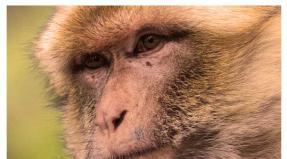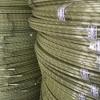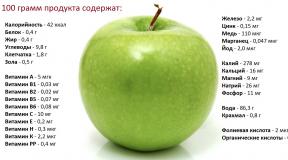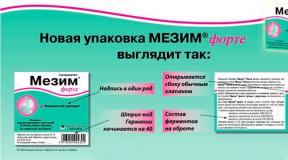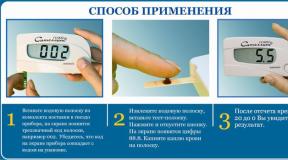Anatomy of the human temporal bone. Temporal bone of the skull. Temporal bone: anatomy Anterior surface of the pyramid
Os temporale, steam room, is involved in the formation of the base of the skull and the lateral wall of its vault. It contains the organ of hearing and balance. It articulates with and is the support of the chewing apparatus.
On the outer surface of the bone there is an external auditory opening, porus acusticus externus, around which there are three parts of the temporal bone; above - the scaly part, inside and behind - the stony part, or pyramid, in front and below - the drum part.
The scaly part, pars squamosa, is shaped like a plate and is located almost in the sagittal direction. The outer temporal surface, facies temporalis, of the squamous part is slightly rough and slightly convex. In the posterior part of it, the groove of the middle temporal artery, sulcus arteriae temporalis mediae (trace of the adjoining artery of the same name) passes in the vertical direction.
In the posterior inferior part of the scaly part, an arcuate line passes, which continues into the lower temporal line, linea temporalis inferior,.
From the scaly part, above and somewhat anterior to the external auditory opening, the zygomatic process, processus zygomaticus, departs in the horizontal direction. It is, as it were, a continuation of the supramastoid crest, crista supramastoidea, located horizontally along the lower edge of the outer surface of the scaly part. Beginning with a broad root, the zygomatic process then narrows. It has an inner and outer surface and two edges - a longer upper and lower, shorter one. The anterior end of the zygomatic process is serrated. The zygomatic process of the temporal bone and the temporal process, processus temporalis, of the zygomatic bone are connected using the temporo-zygomatic suture, sutura temporozygomatica forming the zygomatic arch, arcus zygomaticus.
On the lower surface of the root of the zygomatic process is a transversely oval mandibular fossa, fossa mandibularis. The anterior half of the fossa, up to the stony-squamous fissure, is the articular surface, facies articularis, of the temporomandibular joint. In front of the mandibular fossa limits the articular tubercle, tuberculum articulare.

The outer surface of the squamous part is involved in the formation of the temporal fossa,
fossa temporalis (bundles begin here, m. temporalis).
The inner cerebral surface, facies cerebralis, is slightly concave. It has finger-like depressions, impressiones digitatae, as well as an arterial groove, sulcus arteriosus (it contains the middle meningeal artery, a. meningea media).
The squamous part of the temporal bone has two free edges - sphenoid and parietal.
The anteroinferior sphenoid margin, margo sphenoidalis, is wide, serrated, joins with the scaly margin of the greater wing of the sphenoid bone and forms a wedge-squamous suture, sutura sphenosquamosa.
The upper posterior parietal edge, margo parietalis, is pointed, longer than the previous one, connected to the scaly edge of the parietal bone.
The pyramid (stony part), pars petrosa, of the temporal bone consists of the posterolateral and anteromedial sections.

The posterolateral part of the petrous part of the temporal bone is the mastoid process, processus mastoideus, which is located posterior to the external auditory opening. It distinguishes between the outer and inner surfaces. The outer surface is convex, rough and is the site of muscle attachment. From top to bottom, the mastoid process passes into a cone-shaped protrusion, which is well palpable through the skin,
On the inside, the process is limited by a deep mastoid notch, incisura mastoidea (the posterior belly of the digastric muscle, venter posterior m. digastrici, originates from it). Parallel to the notch and somewhat posteriorly is the sulcus of the occipital artery, sulcus arteriae occipitalis (a trace of the adjacent artery of the same name).

On the inner, cerebral, surface of the mastoid process, there is a wide S-shaped groove of the sigmoid sinus, sulcus sinus sigmoidei, passing at the top into the groove of the parietal bone of the same name and further into the groove of the transverse sinus of the occipital bone (it contains the venous sinus, sinus transversa). From top to bottom, the sulcus of the sigmoid sinus continues as the sulcus of the occipital bone of the same name.
Behind the border of the mastoid process is the jagged occipital margin, margo occipitalis, which, connecting with the mastoid margin of the occipital bone, forms the occipital-mastoid suture, sutura occipitomastoidea. In the middle of the length of the suture or in the occipital margin there is a mastoid opening, foramen mastoideum (sometimes there are several of them), which is the location of the mastoid veins, vv. emissariae mastoidea, connecting the saphenous veins of the head with the sigmoid venous sinus, as well as the mastoid branch of the occipital artery, ramus mastoideus a. occipitalis.
From above, the mastoid process is bounded by the parietal edge, which, on the border with the same edge of the squamous part of the temporal bone, forms the parietal notch, incisura parietalis; it includes the mastoid angle of the parietal bone, forming the parieto-mastoid suture, sutura parietomastoidea.
At the point of transition of the outer surface of the mastoid process into outer surface squamous part, you can see the remains of the squamous-mastoid suture, sutura squamosomastoidea, which is well expressed on the skull of children.
On the cut of the mastoid process, the bone air-bearing cavities located inside it are visible - mastoid cells, cellulae mastoideae. These cells separate one from the other bone mastoid walls, paries mastoideus. The permanent cavity is the mastoid cave, antrum mastoideum, in the central part of the process; mastoid cells open into it, it connects to the tympanic cavity, cavitas tympanica. The mastoid cells and the mastoid cave are lined with a mucous membrane.
The anteromedial part of the petrous part lies medially from the squamous part and the mastoid process. It has the shape of a trihedral pyramid, the long axis of which is directed from the outside and back to front and medially. The base of the stony part is turned outwards and backwards; the top of the pyramid, apex partis petrosae, is directed inward and anteriorly.
In the stony part, three surfaces are distinguished: anterior, posterior and lower, and three edges: upper, posterior and anterior.
The front surface of the pyramid, facies anterior partis petrosae, is smooth and wide, faces the cranial cavity, goes obliquely from top to bottom and forward and passes into the brain surface of the squamous part. It is sometimes separated from the latter by a stony-scaly gap, fissura petrosquamosa. Almost in the middle of the anterior surface there is an arcuate elevation, eminentia arcuata, which is formed by the anterior semicircular canal of the labyrinth lying under it. Between the elevation and the stony-scaly fissure there is a small platform - the roof of the tympanic cavity, tegmen tympani, under which is the tympanic cavity, cavum tympani. On the front surface, near the top of the stony part, there is a small trigeminal impression, impressio trigemini (place of attachment of the trigeminal node, ganglion trigeminale).
Laterally from the depression is a cleft canal of the large stony nerve, hiatus canalis n. petrosi majoris, from which the narrow groove of the large stony nerve, sulcus n. petrosi majoris. Anterior and somewhat lateral to the indicated hole is a small cleft of the canal of the small stony nerve, hiatus canalis n. petrosi minoris, from which the furrow of the small stony nerve, sulcus n. petrosi minoris.
The posterior surface of the pyramid, facies posterior partis petrosae, as well as the anterior one, faces the cranial cavity, but goes up and back, where it passes into the mastoid process. Almost in the middle of it is a round-shaped internal auditory opening, porus acusticus internus, which leads to the internal auditory canal, meatus acusticus internus (the facial, intermediate, vestibulocochlear nerves, nn. facialis, intermedius, vestibulocochlearis, and also, the artery pass through it and labyrinth vein, a. et v. labirinthi). A little higher and laterally from the internal auditory opening there is a well-defined in newborns, of small depth, a subarc fossa, fossa subarcuata (it includes a process of the dura mater of the brain). Even more lateral lies the slit-like outer aperture of the vestibule aqueduct, apertura externa aqueductus vestibuli, opening into the vestibule aqueduct, aqueductus vestibuli. Through the aperture from the cavity inner ear exits the endolymphatic duct.
The lower surface of the pyramid, facies inferior partis petrosae, rough and uneven, forms part of the lower surface of the base of the skull. On it is a rounded or oval jugular fossa, fossa jugularis (the place where the superior bulb of the internal jugular vein fits).
You will be interested in this read:
Temporal bone, os temporale, a paired bone, has a complex structure, since it performs all 3 functions of the skeleton and not only forms part of the side wall and base of the skull, but also contains the organs of hearing and gravity. It is the product of the fusion of several bones (mixed bone) that exist independently in some animals, and therefore consists of three parts:
- scaly part, pars squamosa;
- drum part, pars tympanica and
- rocky part, pars petrosa.
During the 1st year of life, they merge into a single bone, closing the external auditory canal, meatus acusticus externus, in such a way that the scaly part lies above it, the stony part is medially from it, and the drum part is behind, below and in front. Traces of the fusion of individual parts of the temporal bone remain for life in the form of intermediate sutures and crevices, namely: on the border of pars squamosa and pars petrosa, on the anterior upper surface of the latter - fissura petrosquamosa; in the depths of the mandibular fossa - fissura tympanosquamosa, which is divided by the process of the stony part into fissura petrosquamosa and fissura petrotympanica (the chorda tympani nerve exits through it).

Squamous part, pars squamosa, participates in the formation of the lateral walls of the skull. It belongs to the integumentary bones, i.e., it ossifies on the soil connective tissue and has a relatively simple structure in the form of a vertically standing plate with a rounded edge superimposed on the corresponding edge of the parietal bone, margo squamosa, in the form of fish scales, hence its name.
On the its cerebral surface, facies cerebralis, traces of the brain, digital impressions, impressiones digitatae, and a groove ascending upward from a. meningea media. The outer surface of the scales is smooth, participates in the formation of the temporal fossa and is therefore called facies temporalis. The zygomatic process, processus zygomaticus, departs from it, which goes forward to connect with the zygomatic bone. At its beginning, the zygomatic process has two roots: anterior and posterior, between which there is a fossa for articulation with the lower jaw, fossa mandibularis.

An articular tubercle, tuberculum articulare, is placed on the lower surface of the anterior root, which prevents the head of the lower jaw from dislocating forward with a significant opening of the mouth.

Tympanic part, pars tympanica, temporal bone forms the anterior, inferior, and part of the posterior margin of the external auditory meatus, ossifies endesmally and, like all integumentary bones, has the form of a plate, only sharply curved. The external auditory canal, meatus acusticus externus, is a short canal that goes inward and somewhat forward and leads into the tympanic cavity. The upper edge of its outer opening, poms acusticus externus, and part of the posterior edge are formed by the scales of the temporal bone, and the rest of the length by the tympanic part.

In a newborn, the external auditory canal has not yet been formed, since the tympanic part is an incomplete ring (annulus tympanicus), tightened by the tympanic membrane. Due to this close proximity eardrum outwards in newborns and children early age diseases of the tympanic cavity are more often observed. The stony part, pars petrosa, is so named for the strength of its bone substance, due to the fact that this part of the bone is involved in the base of the skull, and is the bone receptacle of the organs of hearing and gravity, which have a very thin structure and need strong protection from damage. It develops on the basis of cartilage. The second name of this part is the pyramid, given by its shape of a trihedral pyramid, the base of which is turned outward, and the top is forward and inward to the sphenoid bone.
The pyramid has three surfaces: front, back and bottom. The anterior surface is part of the bottom of the middle cranial fossa; the posterior surface faces posteriorly and medially and forms part of the anterior wall of the posterior cranial fossa; the lower surface is turned downwards and is visible only on the outer surface of the base of the skull. The external relief of the pyramid is complex and due to its structure as a container for the middle (tympanic cavity) and inner ear (a bony labyrinth consisting of the cochlea and semicircular canals), as well as the passage of nerves and blood vessels. On the anterior surface of the pyramid, near its apex, there is a slight impression, impressio trigemini, from the node trigeminal nerve(n. trigemini). Two thin grooves pass outward from it, the medial one is sulcus n. petrbsi majoris, and lateral - sulcus n. petrosi minoris. They lead to two similar openings: medial, hiatus canalis n. petrosi majoris, and lateral, hiatus canalis n. petrosi minoris. Outside of these openings, an arched elevation, eminentia arcuata, is noticeable, which is formed due to the protrusion of a rapidly developing labyrinth, in particular the upper semicircular canal.

The surface of the bone between the eminentia arcuata and the squama temporalis forms the roof of the tympanic cavity, tegmen tympani. Approximately in the middle of the back surface of the pyramid is the internal auditory opening, porus acusticus internus, which leads to the internal auditory canal, meatus acusticus internus, where the facial and auditory nerves, as well as the artery and veins of the labyrinth. From the lower surface of the pyramid, facing the base of the skull, departs a thin pointed styloid process, processus styloideus, which serves as the site of attachment of the muscles of the "anatomical bouquet" (mm. Styloglossus, stylohyoideus, stylopharyngeus), as well as ligaments - ligg. stylohyoideum and stylomandibular. The styloid process is part of the temporal bone of branchial origin. Together with lig. stylohyoideum, it is a remnant of the hyoid arch. Between the styloid and mastoid processes is the stylomastoid foramen, foramen stylomastoideum, through which n. facialis and a small artery enters. Medially from the styloid process is a deep jugular fossa, fossa jugularis. Anterior to the fossa jugulalis, separated from it by a sharp ridge, is the external opening of the carotid canal, foramen caroticum externum.

The pyramid has three edges: front, back and top. The short anterior margin forms an acute angle with the scales. In this corner, the opening of the musculotube canal, canalis musculotubarius, leading to the tympanic cavity, is noticeable. This channel is divided by a partition into two sections: upper and lower. Upper, smaller, semi-canal, semicanalis m. tensoris tympani, contains this muscle, and the lower, larger, semicanalis tubae auditivae, is the bone part of the auditory tube, which serves to conduct air from the pharynx into the tympanic cavity. Along the upper edge of the pyramid, which separates the anterior and posterior surfaces, there is a clearly visible groove, sulcus sinus petrosi superiors, - a trace of the same name sinus venosus. The rear edge of the pyramid anterior to the fossa jugularis connects to the basilar part of the occipital bone and forms, together with this bone, sulcus sinus petrosi inferioris - a trace of the lower stony venous sinus.

The outer surface of the base of the pyramid serves as a place of muscle attachment, which is the reason for its outer relief (process, notches, roughness). From top to bottom, it extends into the mastoid process, processus mastoideus. The sternocleidomastoid muscle is attached to it, which maintains the head in balance, necessary for vertical position body. Therefore, the mastoid process is absent in tetrapods and even anthropoid apes and develops only in humans due to their upright posture. On the medial side of the mastoid process there is a deep mastoid notch, incisura mastoidea, - the place of attachment of m. digastricus; even more inwards - a small furrow, sulcus a. occipitalis, - a trace of the artery of the same name. On the outer surface of the base of the mastoid process, a smooth triangle is isolated, which is a place for quick access to the cells of the mastoid process when they are filled with pus.
Inside the mastoid process and contains these cells cellulae mastoideae, which are air cavities separated by bone bars, receiving air from the tympanic cavity, with which they communicate through the antrum mastoideum. On the cerebral surface of the base of the pyramid there is a deep groove, sulcus sinus sigmoidei, where the venous sinus of the same name lies. Canals of the temporal bone. The largest canal is the canalis caroticus, through which the internal carotid artery passes. Starting with its external opening on the lower surface of the pyramid, it rises upward, then bends at a right angle and opens with its internal opening at the top of the pyramid medially from the canalis musculotubarius.
The facial canal, canalis facialis, begins in the depths of the porus acusticus internus, from where the canal first goes forward and laterally to the cracks (hiatus) on the anterior surface of the pyramid; at these openings, the canal, remaining horizontal, turns at a right angle laterally and backward, forming a bend - the knee, geniculum canalis facialis, and then down and ends through the foramen stylomastoideum, located on the lower surface of the temporal bone pyramid.
temporalbone- the paired bone is part of the base and lateral wall of the brain skull and is located between the sphenoid (front), parietal (top) and occipital (rear) bones. The temporal bone is a bone receptacle for the organs of hearing and balance; vessels and nerves pass through its canals. The temporal bone forms a joint with the lower jaw and connects to the zygomatic bone, forming the zygomatic arch. In the temporal bone, a pyramid (stony part) with a mastoid process, a tympanic, and a squamous part are distinguished.
Pyramid, or the stony part is so called because of the hardness of its bone substance and has the shape of a trihedral pyramid. Inside it is the organ of hearing and balance. The pyramid in the skull lies almost in a horizontal plane, its base is turned back and laterally and passes into the mastoid process.
top of the pyramid free, directed forward and medially. There are three surfaces in the pyramid: anterior, posterior, and inferior. The anterior and posterior surfaces face the cranial cavity, the lower surfaces outward and are clearly visible from the side of the outer base of the skull. These surfaces of the pyramid are separated by three edges: front, back and top.
Front surface of the pyramid facing forward and upward. Laterally, it passes into the cerebral surface of the squamous part, from which, in young people, the pyramid is separated by a stony-squamous fissure. Next to this gap on the short front edge of the pyramid is the opening of the musculo-tubal canal. This canal is divided by an incomplete septum into two semi-canals: a semi-canal of the tensor tympanic membrane muscle and a semi-canal of the auditory tube. The semicanal of the auditory tube on the whole skull is visible from the side of its outer base. In the middle part of the front surface of the pyramid, a small arched elevation is visible. It is formed by the anterior (upper) semicircular canal of the bony labyrinth of the inner ear lying in the thickness of the pyramid. Between the arched elevation and the stony-scaly fissure, a flattened section of the anterior surface of the pyramid stands out - the roof of the tympanic cavity. Near the apex on the anterior surface of the pyramid is a trigeminal depression - a trace of the attachment of the trigeminal node of the same nerve. Lateral to the trigeminal depression there are two small openings: the cleft (hole) of the canal of the greater stony nerve, from which the furrow of the greater stony nerve originates. Somewhat anteriorly and laterally there is a cleft (hole) of the canal of the small stony nerve.
The top edge of the pyramid separates the anterior from the posterior. A furrow of the superior stony sinus runs along this edge.
The back surface of the pyramid facing back and medially. Approximately in the middle of the posterior surface of the pyramid there is an internal auditory opening passing into a short wide canal - the internal auditory canal, at the bottom of which there are several openings for the facial (VII pair) and vestibulocochlear (8 pair) cranial nerves, as well as for the artery and veins of the vestibule - cochlear organ. Lateral and above the internal auditory opening is the infraarc fossa. The process of the hard shell of the brain enters this fossa. Below and lateral to it there is a small gap - the outer aperture (hole) of the water supply of the vestibule.
Rear edge of the pyramid separates its back surface from the bottom. A furrow of the inferior stony sinus passes through it. At the lateral end of this groove, next to the jugular fossa, there is a dimple, at the bottom of which there is an external aperture (hole) of the cochlear tubule.
Bottom surface of the pyramid visible from the side of the outer base of the skull and has a complex relief. Closer to the base of the pyramid is a rather deep jugular fossa, on the front wall of which there is a groove ending in the mastoid opening of the tubule of the same name. The jugular fossa does not have a wall on the back side - it is limited by the jugular notch, which, together with the notch of the same name of the occipital bone, forms a jugular foramen on the whole skull. Through it pass the internal jugular vein and three cranial nerves: glossopharyngeal (9th pair), vagus (10th pair) and accessory (11th pair). Anterior to the jugular fossa, the carotid canal begins - the external opening of the carotid canal is located here. The internal opening of the carotid canal opens at the top of the pyramid. In the wall of the carotid canal, near its external opening, there are two small dimples that continue into thin carotid canals that connect the carotid canal to the tympanic cavity.
On the comb separating the external opening of the carotid canal from the jugular fossa, a stony dimple is barely visible. At the bottom of it, the lower opening of the tympanic tubule opens. Lateral to the jugular fossa near the mastoid process, a thin and long styloid process protrudes. Behind it, between the styloid and mastoid processes, there is a stylomastoid foramen, with which the canal of the facial nerve ends in this place (7th pair).
Mastoid, is located behind the external auditory canal and makes up the back of the temporal bone. Above the squamous part of the temporal bone, the mastoid process is separated by the parietal notch. Its outer surface is convex, rough. Muscles are attached to it. At the bottom, the mastoid process is rounded (palpable through the skin), on the medial side it is limited by a deep mastoid notch. Medial to this notch is the sulcus of the occipital artery. At the base of the mastoid process, closer to the posterior edge of the temporal bone, there is an inconstant mastoid opening for the mastoid emissary vein. On the inner surface of the mastoid process facing the cranial cavity, a deep and rather wide groove of the sigmoid sinus is visible. Inside the process are mastoid cells separated from each other by bony septa. The largest of them, the mastoid cave, communicates with the tympanic cavity.
drum part is a small, curved in the form of a gutter, open top plate, connecting with other parts of the temporal bone. Merging with its edges with the scaly part and with the mastoid process, it limits the external auditory opening on three sides (front, bottom and back). The continuation of this opening is the external auditory meatus, which reaches the tympanic cavity. Forming the anterior, inferior, and posterior walls of the external auditory canal, the tympanic part fuses behind with the mastoid process. At the site of this fusion, behind the external auditory opening, a tympanic-mastoid fissure is formed.
In front of the auditory opening under the mandibular fossa there is a tympanic-squamous fissure, into which a narrow bone plate protrudes from the inside - the edge of the roof of the tympanic cavity. As a result, the tympanic-squamous fissure is divided into a stony-squamous fissure lying closer to the mandibular fossa and a stony-squamous fissure (glazer's fissure) located closer to the pyramid. Through this last gap, a branch of the facial nerve, the tympanic string, emerges from the tympanic cavity. The flat process of the tympanic part, facing downward, covers the base of the styloid process in front, forming the sheath of the styloid process.
scaly part is a convex outwards plate with a beveled free upper edge. It is superimposed like scales (scales) on the corresponding edge of the parietal bone and the large wing of the sphenoid bone, and below it is connected to the pyramid, mastoid process and tympanic part of the temporal bone. The outer smooth temporal surface of the vertical part of the scale is involved in the formation of the temporal fossa. On this surface, a furrow passes vertically in the days of the temporal artery.
From the scales, somewhat higher and anterior to the external auditory opening, the zygomatic process originates. It goes forward, where it connects with the temporal process of the zygomatic bone with its serrated end, forming the zygomatic arch. At the base of the zygomatic process is the mandibular fossa, for connection with the condylar (articular) process of the lower jaw. In front, the mandibular fossa is limited by the articular tubercle, which separates it from the infratemporal fossa.
On the cerebral surface, finger-like impressions and arterial grooves are visible - traces of the fit of the middle meningeal artery and its branches.
Canals of the temporal bone
sleepy channel through which the internal carotid artery passes into the cranial cavity, begins on the lower surface of the pyramid. Here, anterior to the jugular fossa, is the external opening of the carotid canal. Further, the carotid canal rises upward, bends at a right angle, goes forward and medially. The canal to the cranial cavity is opened by the internal opening of the carotid canal.
Musculo-tubal canal has a common wall with the carotid canal. It starts in the corner formed by the apex of the pyramid and the squamous part of the temporal bone, goes in the thickness of the bone posteriorly and laterally, parallel to the anterior surface of the pyramid. The musculoskeletal canal is divided by a longitudinal horizontal partition into two semi-canals. The upper semi-canal is occupied by the muscle that strains the eardrum, and the lower one is the bone part of the auditory tube. Both semi-channels open into the tympanic cavity on its anterior wall.
front channel in which the facial nerve passes, begins at the bottom of the internal auditory canal, then in the thickness of the pyramid goes horizontally from back to front, perpendicular to its longitudinal axis. Having reached the level of the cleft of the canal of the large stony nerve, the facial canal leaves laterally and posteriorly at a right angle, forming a bend - the knee of the facial canal. Further, the channel follows horizontally along the axis of the pyramid in the direction of its base. Then it turns vertically down, bending around the tympanic cavity, and on the lower surface of the pyramid ends with a stylomastoid opening.
Drum string tubule starts from the canal of the facial nerve, slightly above the stylomastoid opening, goes forward and opens into the tympanic cavity. In this tubule passes a branch of the facial nerve - a tympanic string, which then exits the tympanic cavity through the stony-tympanic fissure.
drum tubule begins in the depths of the stony hole, goes up, pierces the lower wall of the tympanic cavity and continues on the labyrinth wall of this cavity on the surface of the cape in the form of a furrow. Then it perforates the septum of the musculo-tubal canal and ends with a cleft of the canal of the small stony nerve on the anterior surface of the pyramid. In the tympanic tubule passes the tympanic nerve - a branch of the 9th pair of cranial nerves.
mastoid tubule originates in the jugular fossa, crosses the facial canal in its lower part and opens into the tympanic-mastoid fissure. The ear branch passes through this tubule. vagus nerve.
Carotid tubules(two) begin on the wall of the carotid canal (near its outer opening) and penetrate into the tympanic cavity. Serve for passage into the tympanic cavity of the nerves of the same name.
It is impossible to say exactly which bones present in the human body are more important than others. All of them are an integral part of the musculoskeletal system, and damage to one of them can lead to unpredictable consequences. The temporal bone of the skull is no exception and has its own characteristics.
The role and features of the temporal bone
First of all, it should be noted that the temporal bone of the skull is a steam room. Both parts are located in the center of the skull on both sides. Around them are localized occipital, parietal, cuneiform bones. These areas perform a protective function. The organs of hearing and balance are attached to them. In addition, they serve as a support for the lower cheekbone, forming the base and lateral part of the skull. Together with the cheekbones, this element forms a movable joint.
The temporal part of the skull has the following purpose.
- The main function of the paired element is to protect the brain from direct physical influences.
- Of no small importance is the supporting function, due to which the brain is fixed from both sides.
- The muscles of the head are attached to this bone.
- It is a conductor for various vessels, having many channels.
The right and left parts have an identical anatomical structure.
Anatomy
The outer side of the temporal lobe contains the ear canal, around which three sections are localized.
- scaly - located above the temple;
- the stony part of the temporal bone, located on the back side closer to the center, it is also called the pyramid;
- tympanic department, which is localized at the bottom of the anterior part.
The pyramid has three planes, which is why it got its name.
scaly department
This area looks like a kind of plate. Its outer side is somewhat convex and has roughness. From the back, vertically, a groove for the temporal artery is localized. At the bottom there is a curved line, and closer to the frontal part upwards, the bone has a horizontal extension - the process of the lower jaw, visually representing the extension of the comb protrusion, passing along the lower edge of the outer side. Its base is presented in the form of a pot-bellied root, and towards the end it tapers.
The process also has a back, outer side and edges, one of which is longer than the other. The base of the element has small teeth.
The processes of the temporal lobe at its base have a joint resembling a seam. This is how the zygomatic arch is obtained, under which the mandibular recess is localized. It has an egg-shaped shape, stretched across. Ahead of the recess there is a tuberous body. The outer side of the squamous plate forms a depression where the muscle tissue joins. From the inside, finger-shaped furrows and a vascular canal are observed.
As already found out, the scaly region has 2 edges: wedge-shaped and parietal. The first wide edge has teeth; it joins in the region of the sphenoid bone. The upper dorsal parietal edge is somewhat longer than the first. It has a pointed shape and converges in the parietal lobe.
The anatomy of the temporal bone has a complex bone structure. Its pyramidal part consists of two sections: the frontal median and the dorsal lateral, represented by the mastoid bone, localized behind the ear canal. It has a double-sided rough convex plane. Muscles are attached to it, and from top to bottom, the process is smoothly formed into a cone-shaped protrusion. It can be felt when pressed through the epidermis.
The inner fragment has a deep opening. Parallel to it, next to the back is the groove of the occipital blood vessels. The back side of the process ends with notches, and a suture is formed at the junction, in the center of which, a mastoid opening is localized. Sometimes there may be several. Connecting veins pass through the same place. At the top, this process ends with a parietal edge. At the junction of the pyramidal and squamous regions, a recess is formed, into which the corner of the parietal bone enters, due to which a seam is formed.
Pyramid planes
The anatomy of the pyramid of the temporal bone has three planes. One of them is directed inward at an angle, gradually moving to the surface of the scaly section. In the middle of the frontal part there is a horseshoe-shaped hill, which is formed by the anterior groove of the oval-shaped ear canal located below. Between this passage and the tubercle, the plane of the tympanic region is localized.
The rear plane is located similarly to the front, only facing the rear upper region. Its continuation is the mastoid process, and the ear opening is localized in the center of the plane.
The anatomy of the lower plane differs from the other two and has an uneven, rough surface. It is a fragment of the lower base of the cranium. There is also an egg-shaped jugular depression. At the bottom of this fossa there is a small canal leading to the mastoid process. Its back part is limited by a notch, divided by a process into two halves.
The edges of the rocky area
At the top of the pyramid there is a channel, which is designed for the transverse sinus and fixing the sheet with a solid meninges. The dorsal edge is located between the posterior and lower planes of the rocky part. On the upper plane along the posterior edge passes the channel of the sinus of the pyramid. Almost in the very center, near the jugular notch, there is a small depression in the shape of a triangle.
The front edge of the pyramid is somewhat shorter in length than the back or top. There is a small gap between it and the scaly fragment, as well as a hole that opens into the cranial cavity.
pyramidal canals
Inside the walls of the cranium are the canals of the temporal bone. Sleepy departs from the outer opening of the lower plane of the pyramid. It rushes up, and then levels off in the middle and exits with a hole at its top. The atlas of carotid tympanic tubules is presented as its offshoots leading inwards. At the bottom of the ear canal there is an entrance to the facial canal, which runs horizontally at right angles to the axis of the pyramid. Then he rushes to the frontal plane, where, turning sharply, forms a kind of knee. After that, he goes to the middle of the back wall, heading back, runs parallel to the axis of the pyramid to its top. Further, the canal goes vertically down, rushing to the stylomastoid foramen.
String channel
This canal originates slightly below the exit of the facial opening, rushing up the frontal wall of the tympanic plane, and ends on the back wall. A string is a branching of the median nerve passing along this path, which is output through the gap of the stony-tympanic joint.
Muscular auditory canal
This outlet is a kind of continuation of the upper front side of the tympanic cavity. Its exit is localized near the notch, between the pyramid and the scaly plate. It runs from the lateral part to the horizontal axis of the carotid tubule. In addition, it has an internal horizontal wall that divides it into two halves. The upper cavity is occupied by the muscles responsible for the membrane, and the lower part is presented as a tubal auditory canal to the main ear opening.
The path starts from the lower plane of the pyramid at the bottom of the pyramidal recess. It is directed towards the lower cavity, and then passes in the middle of the wall, bypassing the furrow of the cape. After that, it rushes to the upper platform, and then exits outside in the cleft of the canal, where the nerve branch stretches.
Tympanic bone
The tympanic region is endowed with the smallest area, unlike other regions of the temporal lobe. It is a bent ring-shaped plate. This part of the temporal plate forms an external auditory opening on three sides, which indicates its shape. In addition, the boundary gap is localized here - the articulation of the tympanic region with the pyramid, dividing it with the jaw recess. The outer part is expressed by a scaly plane and separates the ear canal. Near the back side of the upper outer part there is a process, under which there is an overpass depression.
Damage
The temporal region can be subject to various injuries, but the most dangerous of them is a fracture. Bone injury can be transverse or longitudinal. Such injuries have one feature - the absence of displacement of debris. This suggests that the width of the crack is insignificant, and the fusion of the bone occurs quickly, which cannot be said about the defeat of scaly surfaces.
Examination of the temporal bones
At the slightest suspicion of damage to the temporal bones, specialists use computed tomography, which makes it possible to identify various kinds of violations in great detail. A feature of this technique is the layer-by-layer diagnosis of the bone.
For the final diagnosis, several pictures are taken, and the following factors are indications for examination.
- Unilateral or bilateral injuries.
- Otitis media of indeterminate form or character.
- Violation hearing characteristics, impaired coordination, as well as other dysfunctions of nearby organs.
- With tumor symptoms, both internal and external.
- Disorders of brain activity associated with damage to the temporal lobe.
- Otosclerosis.
- Mastoiditis.
- Discharge from the ears.
Contraindications for the study
Computer diagnostic methods are considered very popular, as they allow you to get a detailed clinical picture with the slightest details for any bone injuries. This technique is carried out using ionized rays and a special substance introduced into the body. Therefore, in some cases, its use can be hazardous to health. Tomography is not recommended for use under the following circumstances.
- Women during pregnancy. Irradiation has a negative effect on the fetus, which in the future can cause irreversible pathological disorders.
- Excess weight. This diagnostic method was not originally intended for obese people.
- Individual intolerance to the administered drug. The contrast agent may cause allergic reactions.
- At kidney failure the substance does not leave the body and can have a negative effect.
Here are the most common factors that are contrary to the use of CT, however, there are other contraindications, but they are extremely rare.
scaly part, pars squamosa, has the shape of a plate and is located almost in the sagittal direction. outer temporal surface, facies temporalis, the scaly part is slightly rough and slightly convex. In the posterior part of it, the groove of the middle temporal artery passes in the vertical direction, sulcus arteriae temporalis mediae
In the posterior inferior part of the squamous part, an arcuate line passes, which continues into the lower temporal line, linea temporalis inferior, parietal bone.
rice. 49. Skull, cranium; right side view (semi-schematically).From the squamous part, above and somewhat anterior to the external auditory opening, the zygomatic process extends in the horizontal direction, processus zygomaticus. It is, as it were, a continuation of the supramastoid crest, crista supramastoidea, located horizontally along the lower edge of the outer surface of the scaly part (see Fig.). Beginning with a broad root, the zygomatic process then narrows. It has an inner and outer surface and two edges - a longer upper and lower, shorter. The anterior end of the zygomatic process is serrated. The zygomatic process of the temporal bone and the temporal process, processus temporalis, the zygomatic bone are connected using the temporo-zygomatic suture, sutura temporozygomatica, forming the zygomatic arch, arcus zygomaticus.
On the lower surface of the root of the zygomatic process is a transversely oval-shaped mandibular fossa, fossa mandibularis. The anterior half of the fossa, up to the stony-squamous fissure, is the articular surface, facies articularis, temporomandibular joint. Anteriorly, the mandibular fossa limits the articular tubercle, tuberculum articulare, (see Fig. , ).
 rice. 51. Skull (X-ray, lateral view). 1 - parietal bone; 2 - Turkish saddle; 3 - back of the saddle; 4 - slope; 5 - occipital bone; 6 - temporal bone (stony part); 7 - II cervical vertebra; 8 - transverse process; 9 - awned process; 10 - condylar process of the lower jaw; eleven - lower jaw; 12 - incisors of the lower jaw; 13 - incisors of the upper jaw; 14 - upper jaw; 15 - maxillary sinus; 16 - anterior nasal spine; 17 - coronoid process of the lower jaw; 18 - infraorbital margin; 19 - eye socket; 20 - sphenoid sinus; 21 - anterior inclined process; 22 - nasal bone; 23- frontal sinus; 24 - frontal bone.
rice. 51. Skull (X-ray, lateral view). 1 - parietal bone; 2 - Turkish saddle; 3 - back of the saddle; 4 - slope; 5 - occipital bone; 6 - temporal bone (stony part); 7 - II cervical vertebra; 8 - transverse process; 9 - awned process; 10 - condylar process of the lower jaw; eleven - lower jaw; 12 - incisors of the lower jaw; 13 - incisors of the upper jaw; 14 - upper jaw; 15 - maxillary sinus; 16 - anterior nasal spine; 17 - coronoid process of the lower jaw; 18 - infraorbital margin; 19 - eye socket; 20 - sphenoid sinus; 21 - anterior inclined process; 22 - nasal bone; 23- frontal sinus; 24 - frontal bone.  rice. 50. Skull (roentgenogram, posteroanterior projection). 1 - parietal bone; 2 - frontal bone; 3 - temporal bone (stony part); 4 - zygomatic bone; 5 - condylar process of the lower jaw; 6 - coronoid process of the lower jaw; 7 - maxillary sinus: 8 - upper jaw; 9 - tooth (upper lateral incisor); 10 - lower jaw; 11 - lower nasal concha; 12 - bony septum of the nose; 13 - middle nasal concha; 14 - temporal bone; 15 - eye socket; 16 - frontal sinus; 17 - partition of the frontal sinuses.
rice. 50. Skull (roentgenogram, posteroanterior projection). 1 - parietal bone; 2 - frontal bone; 3 - temporal bone (stony part); 4 - zygomatic bone; 5 - condylar process of the lower jaw; 6 - coronoid process of the lower jaw; 7 - maxillary sinus: 8 - upper jaw; 9 - tooth (upper lateral incisor); 10 - lower jaw; 11 - lower nasal concha; 12 - bony septum of the nose; 13 - middle nasal concha; 14 - temporal bone; 15 - eye socket; 16 - frontal sinus; 17 - partition of the frontal sinuses. The outer surface of the squamous part is involved in the formation of the temporal fossa, fossa temporalis, (here the bundles of the temporal muscle begin, m. temporalis).
Inner cerebral surface facies cerebralis, slightly concave. It has finger-like indentations, impressiones digitatae, as well as the arterial sulcus, sulcus arteriosus, (it contains the middle meningeal artery, a. meningea media).
The squamous part of the temporal bone has two free edges - sphenoid and parietal.
Antero-inferior wedge-shaped edge, margo sphenoidalis, wide, serrated, connects to the scaly edge of the large wing of the sphenoid bone and forms a wedge-scaly suture, sutura sphenosquamosa. superior posterior parietal margin, margo parietalis, pointed, longer than the previous one, connected to the scaly edge of the parietal bone.
Pyramid of the temporal bone
Pyramid, rocky part - pars petrosa, the temporal bone consists of posterolateral and anteromedial sections.
The posterolateral part of the petrous part of the temporal bone is the mastoid process, processus mastoideus, which is located posterior to the external auditory opening. It distinguishes between the outer and inner surfaces. The outer surface is convex, rough and is the site of muscle attachment. From top to bottom, the mastoid process passes into a cone-shaped protrusion, which is well palpable through the skin,
On the inside, the process is limited by a deep mastoid notch, incisura mastoidea, (the posterior belly of the digastric muscle originates from it, venter posterior m. digastrici). Parallel to the notch and somewhat posteriorly is the sulcus of the occipital artery, sulcus arteriae occipitalis, (trace of the adjacent artery of the same name).
On the inner, cerebral, surface of the mastoid process there is a wide S-shaped groove of the sigmoid sinus, sulcus sinus sigmoidei, passing at the top into the sulcus of the parietal bone of the same name and further into the sulcus of the transverse sinus of the occipital bone (the venous sinus lies in it, sinus transversa). From top to bottom, the sulcus of the sigmoid sinus continues as the sulcus of the occipital bone of the same name.
Behind the border of the mastoid process is a jagged occipital margin, margo occipitalis, which, connecting with the mastoid edge of the occipital bone, forms the occipital-mastoid suture, sutura occipitomastoidea. In the middle of the length of the seam or in the occipital margin is the mastoid opening, foramen mastoideum, (sometimes there are several), which is the location of the mastoid veins, vv. emissariae mastoidea connecting the saphenous veins of the head with the sigmoid venous sinus, as well as the mastoid branch of the occipital artery, ramus mastoideus a. occipitalis.
From above, the mastoid process is bounded by the parietal edge, which, on the border with the same edge of the squamous part of the temporal bone, forms a parietal notch, incisura parietalis; it includes the mastoid angle of the parietal bone, forming the parieto-mastoid suture, sutura parietomastoidea.
At the point of transition of the outer surface of the mastoid process into the outer surface of the squamous part, one can notice the remains of the squamous-mastoid suture, sutura squamosomastoidea, which is well expressed on the skull of children.
On the cut of the mastoid process, the bone air-bearing cavities located inside it are visible - mastoid cells, cellulae mastoideae, (rice. ). These cells separate one from the other bone mastoid walls (paries mastoideus). The permanent cavity is the mastoid cave, antrum mastoideum, in the central part of the process; mastoid cells open into it, it connects to the tympanic cavity, cavitas tympanica. The mastoid cells and the mastoid cave are lined with a mucous membrane.
The anteromedial part of the petrous part lies medially from the squamous part and the mastoid process. It has the shape of a trihedral pyramid, the long axis of which is directed from the outside and back to front and medially. The base of the stony part is turned outwards and backwards; top of the pyramid apex partis petrosae, directed inward and anteriorly.
In the stony part, three surfaces are distinguished: anterior, posterior and lower, and three edges: upper, posterior and anterior.
The anterior surface of the pyramid facies anterior partis petrosae, (see Fig. ) smooth and wide, facing the cranial cavity, directed obliquely from top to bottom and forward and passes into the cerebral surface of the squamous part. It is sometimes separated from the latter by a stony-scaly gap, fissura petrosquamosa. Almost in the middle of the front surface there is an arcuate elevation, eminentia arcuata, which is formed by the anterior semicircular canal of the labyrinth lying under it. Between the elevation and the stony-scaly fissure there is a small platform - the roof of the tympanic cavity, tegmen tympani under which is the tympanic cavity, cavum tympani. On the anterior surface, near the top of the petrous part, there is a small trigeminal depression, impressio trigemini, (place of attachment of the trigeminal node, ganglion trigeminale).
Lateral to the impression is a cleft canal of the large stony nerve, , from which the narrow groove of the large stony nerve extends medially, sulcus n. petrosi majoris. Anterior and somewhat lateral to the specified hole is a small cleft canal of the small stony nerve, hiatus canalis n. petrosi minoris, from which the furrow of the small stony nerve is directed, sulcus n. petrosi minoris.
Back surface of the pyramid facies posterior partis petrosae, (see fig. ) as well as the anterior one, faces the cranial cavity, but goes up and backwards, where it passes into the mastoid process. Almost in the middle of it is a round-shaped internal auditory opening, porus acusticus internus, which leads to the internal auditory canal, meatus acusticus internus (the facial, intermediate, vestibulocochlear nerves pass through it, nn. facialis, intermedius, vestibulocochlearis, as well as the artery and vein of the labyrinth, a. et v. labyrinthi). A little higher and laterally from the internal auditory opening there is a well-defined in newborns, a small depth of the infraarc fossa, fossa subarcuata, (it includes the process of the hard shell of the brain). Even more lateral lies the slit-like outer aperture of the water supply of the vestibule, apertura externa aqueductus vestibuli, opening into the water supply of the vestibule, aqueductus vestibuli. Through the aperture, the endolymphatic duct exits the cavity of the inner ear.
The bottom surface of the pyramid facies inferior partis petrosae, (see Fig. ), rough and uneven, forms part of the lower surface of the base of the skull. On it is a rounded or oval jugular fossa, fossa jugularis, (place of attachment of the superior bulb of the internal jugular vein).
At the bottom of the fossa, a small groove is noticeable (the ear branch of the vagus nerve passes through it). The sulcus leads into the opening of the mastoid tubule, canaliculus mastoideus, which opens in the tympanomastoid fissure, fissura tympanomastoidea.
The posterior edge of the jugular fossa is bounded by the jugular notch, incisura jugularis, which is a small intrajugular process, processus intrajugularis, divides into two parts - anteromedial and posterolateral. Anterior to the jugular fossa lies a rounded opening; it leads to sleep canal, canalis caroticus, opening at the top of the rocky part.
Between the anterior circumference of the jugular fossa and the external opening of the carotid canal there is a small stony dimple, Fossula petrosa, (place of attachment of the lower node of the glossopharyngeal nerve). In the depths of the dimple there is a hole - a passage into the tympanic tubule, canaliculus tympanies, (the tympanic nerve and the lower tympanic artery pass through it). The tympanic tubule leads to the middle ear auris media, or tympanic cavity, cavum lympani), cavitas tympanies).
Laterally from the jugular fossa, the styloid process protrudes downward and somewhat anteriorly, processus styloideus from which muscles and ligaments begin. Ahead to the outside of the base of the process descends the bone protrusion of the tympanic part - the sheath of the styloid process, vagina processus styloidei. Behind the base of the process there is a stylomastoid opening, foramen stytomastoideum, which is the outlet of the facial canal, canalis facialis.
The top edge of the pyramid marge superior partis petrosae, (see Fig. , ), separates its front surface from the back. A furrow of the superior stony sinus runs along the edge, sulcus sinus petrosi superioris, - the imprint of the superior stony venous sinus lying here and the attachment of the cerebellar tenon - part of the hard shell of the brain. This sulcus passes posteriorly into the sulcus of the sigmoid sinus of the mastoid process of the temporal bone.
The rear end of the pyramid margo posterior partis petrosae, (see Fig.), separates its back surface from the bottom. Along it, on the cerebral surface, there is a furrow of the inferior stony sinus, sulcus sinus petrosi inferioris, (see Fig. ) (a trace of the fit of the lower stony venous sinus). Almost in the middle of the posterior edge, near the jugular notch, there is a triangular funnel-shaped depression in which the outer aperture of the cochlear tubule lies, apertura externa canaliculi cochleae, it ends with a snail tubule, canaliculus cochleae.
 rice. 117. Internal base of the skull, basis cranii interna; top view (semi-schematically). 1 - anterior cranial fossa, fossa cranii anterior; 2 - middle cranial fossa, fossa cranii media; 3 - posterior cranial fossa, fossa cranii posterior.
rice. 117. Internal base of the skull, basis cranii interna; top view (semi-schematically). 1 - anterior cranial fossa, fossa cranii anterior; 2 - middle cranial fossa, fossa cranii media; 3 - posterior cranial fossa, fossa cranii posterior.
The anterior margin of the petrous part, located on the lateral side of its anterior surface, is shorter than the upper and posterior ones; it is separated from the squamous part of the temporal bone by a stony-scaly fissure, fissura petrosquamosa. On it, lateral to the internal opening of the carotid canal, there is an opening of the musculo-tubal canal leading to the tympanic cavity.
Canals and cavities of the petrous part of the temporal bone:- dream channel, canalis caroticus, (see Fig. -), begins in the middle sections of the lower surface of the stony part with an outer opening. At first, the canal goes up, located here in front of the middle ear cavity, then, bending, it follows anteriorly and medially and opens at the top of the pyramid with an internal opening (the internal carotid artery, the accompanying veins and the plexus of sympathetic nerve fibers pass through the carotid canal).
- carotid tubules, canaliculi caroticotympanici, are two small tubules that branch off from the carotid canal and lead to the tympanic cavity (the carotid-tympanic nerves pass through them).
- face channel, canalis facialis, (see Fig. , , ), begins at the bottom of the internal auditory canal, meatus acusticus internus, (in the field of the facial nerve, area n. facialis). The canal runs horizontally and almost at right angles to the axis of the stony part, goes to its front surface, to the cleft of the canal of the large stony nerve, hiatus canalis n. petrosi majoris. Here, turning at a right angle, it forms the knee of the facial canal, geniculum canalis facialis, and passes to the posterior part of the medial wall of the tympanic cavity (respectively, on this wall of the tympanic cavity there is a protrusion of the facial canal, prominentia canalis facialis). Further, the channel, heading backwards, follows along the axis of the rocky part to the pyramidal elevation, eminentia pyramidalis; from here it goes vertically down and opens with a stylomastoid foramen, foramen stylomastoideum, (the facial and intermediate nerves, arteries and veins pass through the canal).
- drum string tubule, canaliculus chordae tympani, begins on the outer wall of the facial canal, a few millimeters above the stylomastoid foramen. Heading forward and upward, the tubule enters the tympanic cavity and opens on its back wall (a branch of the intermediate nerve passes through the tubule - the tympanic string, chorda tympani, which, having entered the tympanic cavity through the tubule, leaves it through the stony-tympanic fissure, fissura petrotympanica).
- drum tubule, canaliculus tympanicus, begins on the lower surface of the stony part, in the depths of the stony dimple. Then he goes to the lower wall of the tympanic cavity and, perforating it, enters the tympanic cavity, passes through it medial wall and is located in the furrow of the cape, sulcus promontorii. Then it follows to the upper wall of the tympanic cavity, where it opens with a cleft canal of the small stony nerve (hiatus canalis n. petrosi minoris).
- musculoskeletal canal, canalis musculotubarius, (see Fig. , , ), is a continuation of the anterior upper part of the tympanic cavity. The external opening of the canal is located at the notch between the stony and squamous parts of the temporal bone, at the anterior end of the stony-squamous fissure. The canal is located lateral and slightly posterior to the horizontal part of the carotid canal, almost along the longitudinal axis of the petrous part. Horizontally located septum of the musculo-tubal canal, septum canalis musculotubarii, divides the canal into the upper smaller half-capal of the muscle that strains the eardrum, semicanals m. tensoris tympani, and the lower greater palucanal of the auditory tube, semicanals lubae auditivae, (in the first lies a muscle that strains the eardrum, the second connects the tympanic cavity with the pharyngeal cavity.
- mastoid canal, canaliculus mastoideus, (see Fig. ), begins in the depths of the jugular fossa, runs across the lower part of the facial canal and opens in the tympanic-mastoid fissure (the ear branch of the vagus nerve passes through the tubule).
- tympanic cavity, cavum tympani, (see Fig. , , ). - an elongated, laterally compressed cavity lined with a mucous membrane. Inside the cavity lie three auditory ossicles: hammer, malleus, anvil, incus, and stirrup (stapes), which, articulated with each other, form a chain of auditory ossicles (more about the structure of these canals, the tympanic cavity, the auditory ossicles and the labyrinth.
Tympanic part of the temporal bone
drum part, pars tympanlca, (see fig.), - the smallest section of the temporal bone. It is a slightly curved annular plate and forms the anterior, inferior walls and part of the posterior wall of the external auditory canal, meatus acusticus extenus. Here you can also see the border tympanic-squamous fissure, fissura tympanosquamosa (see Fig. ,), which, together with the stony-squamous fissure, separates the tympanic part from the mandibular fossa of the squamous part. The outer edge of the tympanic part, closed on top by the scales of the temporal bone, limits the external auditory opening, porus acusticus externus. At the posterior upper outer edge of this hole there is a supra-anal spine, spina suprameatica. Beneath it is the suprapassal fossa, foveola suprameatica. On the border of the larger, inner, and smaller, outer, parts of the external auditory canal, there is a tympanic sulcus, Sulcus tympanicus, (site of attachment of the tympanic membrane). At the top, it is limited by two curved protrusions: in front - a large tympanic spine, spina tympanica major, and behind - a small tympanic spine, spina tympanica minor. Between these protrusions is a tympanic notch (incisura tympanica) that opens into the epitympanic recess, recessus epitympanicus.
Between the medial part of the tympanic part and the squamous part of the temporal bone, the lower process of the roof of the tympanic cavity is wedged. A stony-scaly fissure passes in front of this process, fissura petrosquamosa, and behind - a stony-tympanic fissure, fissura petrotympanica, (a nerve comes out of the latter - a drum string and small vessels). Both furrows continue outwards into the tympanic-squamous fissure, fissura tympanosquamosa.
The lateral part of the tympanic part passes into the stony crest, the elongated part of which forms the sheath of the styloid process, vagina processus styloidei. In a newborn, the external auditory canal is still absent and the tympanic part is represented by the tympanic ring, anulus tympanicus (see Fig.), which then grows, forming a significant part of the external auditory canal.
On the inner surface of the greater tympanic spine, a spinous crest is clearly distinguishable, at the ends of which there are anterior and posterior tympanic processes, and a furrow of the malleus runs along it.


